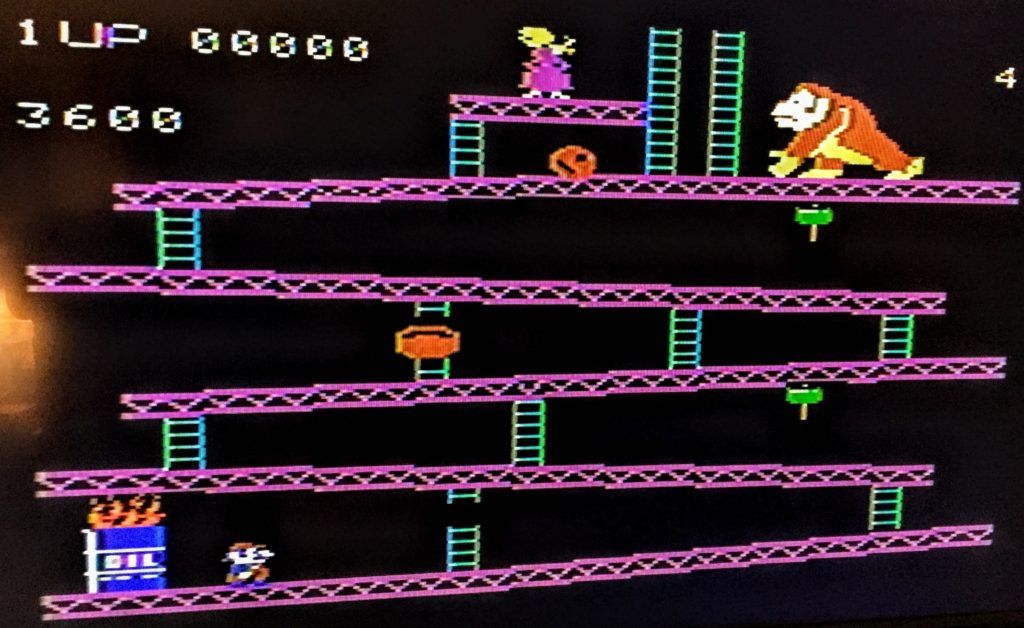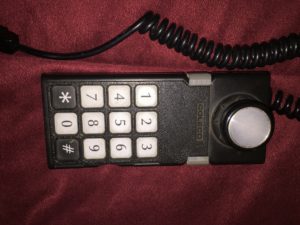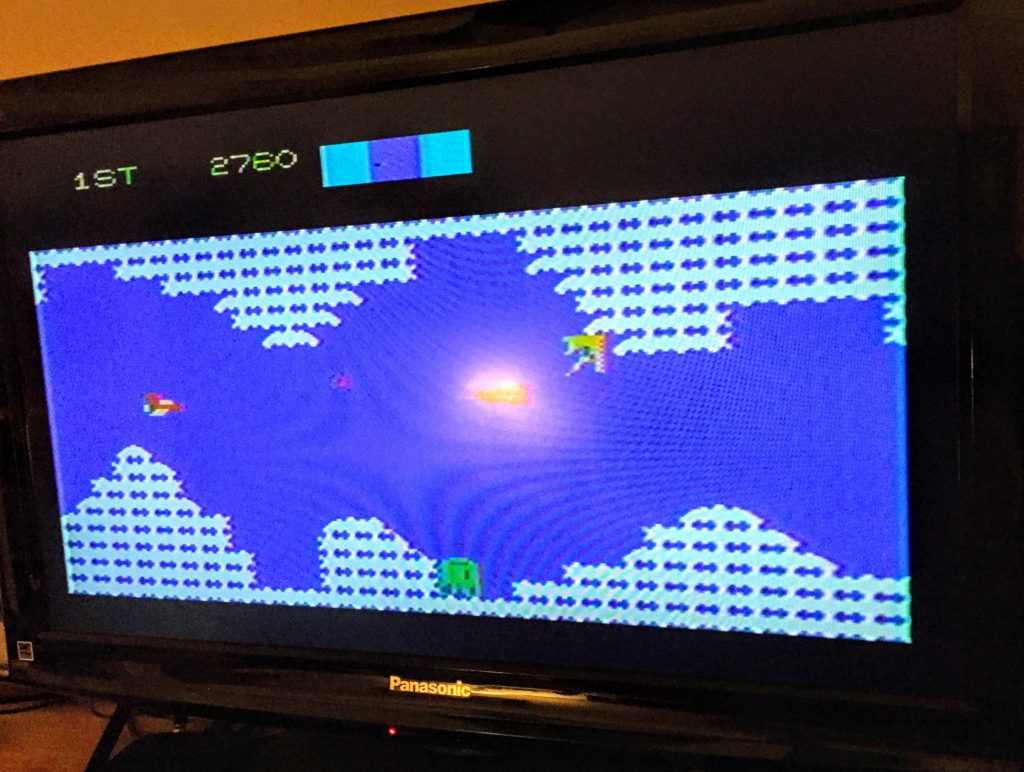If you know anything about classic game systems from the 80s you know that the Atari 2600 broke us all out of basic “Pong” and stormed the market creating a vibrant home game market. But, while it wasn’t one of the first, when the ColecoVision hit the market it set the bar with quality of graphics and sound, rivaling the arcade versions of many of the top games of the day.
Games like Donkey Kong (which was included with the console), Zaxxon and Defender were amazingly just like being at the Arcade with your friends, only without all of the quarters needed to play.

While I didn’t own one as a kid (I had the rival Intellivision system), I had friends that had it and it was the king of the hill when it came to game systems, and all the kids on the playground knew it. This was just before the video game crash of 1983 and it was like the wild west of personal computers and game systems.
What I couldn’t own as a kid, I made sure I owned as a kid-on-the-inside adult. Another of my “great deals” from E-bay became one of the best purchases for family entertainment I had made in a long time.
Now, getting things to work good on your modern HD TV is not as difficult as you would think. But if you run into any problems early, I suggest you do some common sense tests before doing anything drastic. I say this because for some reason, I forgot this seemingly obvious idea of Occam’s razor (the simplest possibility is usually the best) and ended up testing complex potential problems long before just testing the obvious.
So let me walk you through my wondrous tour of the innards of the ColecoVision on my journey to simply discover that my nerd-powers can sometimes get the better of me…
Hmm… thats strange…
When I first connected the ColecoVision to my 55″ Vizio 4K TV, I expected to be greeted with the most amazing retro gaming experience of the century. Everything else I had connected or played on this TV was top notch… why wouldn’t my 30 year old game console?  With the standard connector of its age being a RF modulator for the 80s era analog TVs, the ColecoVision wasnt ready for prime time, but I had it working before on an older HD TV years ago, so it must still work.
With the standard connector of its age being a RF modulator for the 80s era analog TVs, the ColecoVision wasnt ready for prime time, but I had it working before on an older HD TV years ago, so it must still work.
Nope.
Instead what I got was a brief second or two of snowy video where I could just make out the intro screen for the Defender game cartridge I had installed, then it just cut to black, no snow or anything. After cleaning the cartridge and slot in the console (something kids of the 80s and 90s know all too well how to do), and fiddling with the connection on the back, changing connectors between the TV and the console and even going through a DVD player to convert the image from RF to composite I ended up in the same place… the sad town of “deadsville”.
Now this is where my story runs off the rails… and I spend a lot more time and energy than ultimately was necessary. If you have no interest in this story or how to test many parts of the innards of the ColecoVision I suggest you jump to the bottom of this story and see the simple solution, and you should try that before trying anything I am about to reveal… though this info may be of help if your problems have nothing to do with my ultimate non-problem.
Okay, it must be the power supply!
 Now, when I see something work, then drop out, my first inclination is to jump to the power supply, of anything. My hobbies of building custom electronics with TI MSP430 microcontrollers and Arduinos means I have a lot of experience busting out my trusty multimeter and testing inputs and outputs of devices to ensure connections and components are doing what they are supposed to.
Now, when I see something work, then drop out, my first inclination is to jump to the power supply, of anything. My hobbies of building custom electronics with TI MSP430 microcontrollers and Arduinos means I have a lot of experience busting out my trusty multimeter and testing inputs and outputs of devices to ensure connections and components are doing what they are supposed to.
So thats where I started….
First test was to connect the multimeter to the “legend”…wait-for-it…. “dary” humongous power supply and see if it was faulty. It has a strange output of 5V, -5V, 12V & Ground. When I tested the supply it showed a surprisingly low voltage from the 5V & 12V pins… something that led me to, incorrectly, believe it was a faulty power supply. After reading a bit online I heard many people say that you should not test the supply unless it is connected and under load on the console. So to make sure, I decided to open the case and test it.
Oh boy. Opening the console and separateing the top from the bottom case was a pain in the neck.  First I unplugged the unique controllers from their resting place and then began the search for how to open this beast. There are a few videos on Youtube that help, but still, the top case is connected to the front panel and that has a lip that grabs the bottom part of the case. This makes it a bit of challenge to separate the two pieces. But with a bit of careful work, the two come apart.
First I unplugged the unique controllers from their resting place and then began the search for how to open this beast. There are a few videos on Youtube that help, but still, the top case is connected to the front panel and that has a lip that grabs the bottom part of the case. This makes it a bit of challenge to separate the two pieces. But with a bit of careful work, the two come apart.
With them apart the bottom of the console is where all the action happens.

The metal shielding covers the main motherboard, but the first thing I needed to test was the power connectors.

When powered up, the power supply worked perfectly, hitting the positive and negative 5 volts as well as the 12 volts. Which, while surprising, made me feel great.
 So at this point I thought it must be related to the output of the RF. While reading there were many people mentioning that I should replace the old switchbox and simply a simple Radio Shack RCA to F male connector part to connect the RF modulator of the ColecoVision to the TV using the cable connector of the TV.
So at this point I thought it must be related to the output of the RF. While reading there were many people mentioning that I should replace the old switchbox and simply a simple Radio Shack RCA to F male connector part to connect the RF modulator of the ColecoVision to the TV using the cable connector of the TV.
So that is what I did, with a Radio Shack less than a quarter mile from my house it was an easy decision to replace that next. This simple part replaced the old school box and made it a bit easier to connect up. But alas, when connected, nothing different
Alright, at this point it was getting very bleak… I was starting to question my abilities to test and diagnose problems. At this point, people get desparate… and I did.
WTF?!? Let me try another TV!
Okay… this should have been my first step… and yours too. As TVs get more and more sophisticated they are clearly adding advanced circuitry to test for problems in the signal and try to clean up the problem. Because when I brought the ColecoVision up to the bedroom Panasonic flatscreen (only 720p) it worked GREAT… oh… my… god.

So as it turned out, I had neither a power supply problem nor a connection problem, rather, the newest TV I have was just to smart to stay on the channel long enough to get it right. The 4 year old Panasonic HD TV works great. I guess if I want to move the console back to the newer TV, I will need to consider one of the suggested upgrades to Composite, but I will save that for another day. 🙂


waryfax 6d9e6a7a19 https://wakelet.com/wake/oQn9-4oN6rk19F3BfWFCC
nadiyian 00dffbbc3c https://coub.com/stories/4253531-hybrid-strings-electric-violin-kontakt-vst-rar-windows-activator-rar-professional
furgena 00dffbbc3c https://coub.com/stories/4380832-carcassonne-collection-bundle-zip-full-crack-latest-license-windows
jaesqui 219d99c93a https://coub.com/stories/4229595-adobe-illustra-free-build-zip-license-download-x64-pc
jedjare 219d99c93a https://coub.com/stories/4293763-nakalnya-anak-muda-watch-online-kickass-dual-4k
cornmar 219d99c93a https://coub.com/stories/4222711-party-hardcore-dubbed-x264-1080p-mkv-bluray-avi
welvas 219d99c93a https://coub.com/stories/4286931-rar-os-by-william-st-ings-full-edition-download-book-epub
fiampad 219d99c93a https://coub.com/stories/4338130-pc-aladdin-1992-micro-crack-64bit-iso-activator-professional-download
cickes 219d99c93a https://coub.com/stories/4228953-hans-zimmer-pandora-mp3-patch-windows-activator-latest
marvkafl 219d99c93a https://coub.com/stories/4270250-free-the-count-of-monte-cris-abridged-mobi-rar-book-torrent
Thanks a lot for sharing this with all people you really recognise what you are speaking about!
Bookmarked. Kindly also discuss with my website =).
We will have a hyperlink change arrangement among us
Look at my web blog :: binance pump signals telegram
gladlav 219d99c93a https://coub.com/stories/4338647-full-edition-dingrando-quimica-materia-cambio-epub-zip-torrent
nikuerr 219d99c93a https://coub.com/stories/4266199-pc-mg-soft-visual-mib-buil-professional-full-version-exe
bethol 219d99c93a https://coub.com/stories/4384330-epson-wic-reset-utility-utorrent-nulled-ultimate-zip
spicah 219d99c93a https://coub.com/stories/4232449-pc-gpr-slice-v6-0-rar-patch-registration-latest-64bit
traweay 219d99c93a https://coub.com/stories/4364392-intervalzerortx2011-pc-pro-x32-nulled-zip
Looking for SEO services? Or need consultancy in SEO or digital Marketing?
Contact khurram Jamil, He is Google Certified SEO Expert and Trainer.
you can reach him at https://web.facebook.com/khurramjamilseo/
markmahl d9ca4589f4 https://wakelet.com/wake/o9AjWYH7Hqek-vjZQkCOE
kiliema d9ca4589f4 https://wakelet.com/wake/hw7wRzN8QdLQbBMXPFwnX
oldsan d9ca4589f4 https://wakelet.com/wake/CMZCrISFFITch94MxtvUg
malwake d9ca4589f4 https://wakelet.com/wake/iJkFJu3LRGV_QJjg12vt7